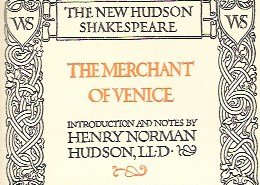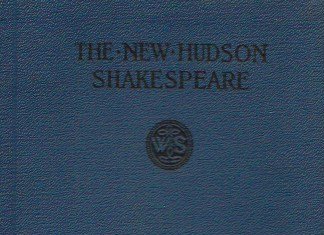The New Hudson Shakespeare: The Merchant of Venice
Edited & revised by Ebenezer Charlton Black, 1906, Ginn & Co., 138 pages with index, flexible board cover.
Very good contain, pages clean, slight tan with age, binding tight, cover clean, owners name on inside front cover.
Theatre has been an important part of British and Irish culture, dating back to the Roman occupation. Medieval mystery plays and morality plays were performed at religious festivals. The reign of Elizabeth I the flowering of drama was personified by William Shakespeare. Puritans banned drama during the Interregnum of 1642—1660, but London theatres opened again with the Restoration of the monarchy in 1660, and flourished thereafter. In the 18th century, highbrow and provocative Restoration comedy was replaced by sentimental comedy, and domestic tragedy (George Lillo's The London Merchant, 1731), and a fascination with Italian opera. The Romanticism period (1798–1836) saw melodramas, light comedies, operas, pantomimes, translations of French farces, and Victorian burlesque. Drama was revived again in the late 19th century with plays on the London stage by the Irishmen George Bernard Shaw and Oscar Wilde and the Norwegian Henrik Ibsen. JM Synge and Noel Coward contributed in the 20th century.
Edited & revised by Ebenezer Charlton Black, 1906, Ginn & Co., 138 pages with index, flexible board cover.
Very good contain, pages clean, slight tan with age, binding tight, cover clean, owners name on inside front cover.
Theatre has been an important part of British and Irish culture, dating back to the Roman occupation. Medieval mystery plays and morality plays were performed at religious festivals. The reign of Elizabeth I the flowering of drama was personified by William Shakespeare. Puritans banned drama during the Interregnum of 1642—1660, but London theatres opened again with the Restoration of the monarchy in 1660, and flourished thereafter. In the 18th century, highbrow and provocative Restoration comedy was replaced by sentimental comedy, and domestic tragedy (George Lillo's The London Merchant, 1731), and a fascination with Italian opera. The Romanticism period (1798–1836) saw melodramas, light comedies, operas, pantomimes, translations of French farces, and Victorian burlesque. Drama was revived again in the late 19th century with plays on the London stage by the Irishmen George Bernard Shaw and Oscar Wilde and the Norwegian Henrik Ibsen. JM Synge and Noel Coward contributed in the 20th century.
Edited & revised by Ebenezer Charlton Black, 1906, Ginn & Co., 138 pages with index, flexible board cover.
Very good contain, pages clean, slight tan with age, binding tight, cover clean, owners name on inside front cover.
Theatre has been an important part of British and Irish culture, dating back to the Roman occupation. Medieval mystery plays and morality plays were performed at religious festivals. The reign of Elizabeth I the flowering of drama was personified by William Shakespeare. Puritans banned drama during the Interregnum of 1642—1660, but London theatres opened again with the Restoration of the monarchy in 1660, and flourished thereafter. In the 18th century, highbrow and provocative Restoration comedy was replaced by sentimental comedy, and domestic tragedy (George Lillo's The London Merchant, 1731), and a fascination with Italian opera. The Romanticism period (1798–1836) saw melodramas, light comedies, operas, pantomimes, translations of French farces, and Victorian burlesque. Drama was revived again in the late 19th century with plays on the London stage by the Irishmen George Bernard Shaw and Oscar Wilde and the Norwegian Henrik Ibsen. JM Synge and Noel Coward contributed in the 20th century.

